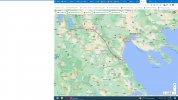Grevena, August 28th, 1943
The Greek and the Italian officer shook hands in front of the photographer. Allied forces had managed to link with the pocket of Italian forces fighting against the Germans. The danger for the Italians was not yet over but at least they now had a line of supply. Or at least a line to retreat...
Naples, August 29th, 1943
The city rose up in revolt at rumors that Allied and Free Italian troops were approaching. After four days of fierce street fighting the Germans would be forced to leave Naples between the rebels and the Allied advance. The Italian "Garibaldi" brigade and elements of the US 82nd Airborne division would be the first to enter liberated Naples.
Copenhagen, August 29th, 1943
For the past three years Denmark was occupied but her government and part of her armed forces remained intact in the country. Now following increasing tensions the Germans moved to disarm the Danish forces. The Danish navy would manage to scuttle most of its ships with four ships managing to escape to neutral Sweden. A single German soldier would be killed during the operation and about half a dozen wounded. Most of the rest of the world would hardly notice.
Aiani, Macedonia, August 30th, 1943
The Maoris of the 28th battalion beat back the German counterattack. The Allied bridgehead across the Aliakmon river was secure. Soon it would be further reinforced and Allied forces start to push out of it.
Thessaloniki, September 3rd, 1943
The railway troops officer was getting exasperated. The Amis had hit the railyards once more. Or it could had been the British. Or the French. Or the Greeks. Or even the Serbs and the Poles, of course Poles were not supposed to be around opposing the Reich any more a contention that the streams of casualties coming back from fighting the Polish Corps might question. Or all of them together. He had heard the Luftwaffe had sent over a hundred aircraft to reinforce the units fighting but the Allied air attacks were not showing any sign of dissipating. As if the bombing was not enough the tracks from here all the way to Belgrade were under constant attack by partisans, putting wagons full of hostages ahead had not stopped them from attacking, any more than reprisals did, and the Bulgarian and German occupation forces were big on reprisals. As if all this was not enough...
"Yawohl herr oberführer the train to Poland will have to waid we had to send a hospital train with wounded to Vienna instead today, I promise it will leave on the fifth. Yes I know the timetable called for four shipments by the fifth and only one was possible, but you understand the situation at the front has to take precedence. I know you didn't have such issues in Constantinople..."
Macedonia, September 7th, 1943
Allied forces liberated Kozani. German and Bulgarian forces were pulling back behind mount Vermion in the East and towards Monastir to the north. The Germans, reinforced by two more divisions, were still contesting ground nearly step by step and so did the Bulgarians further east but they were paying for delaying the Allied advance in blood, their casualties in four weeks of heave fighting were in excess of 50,000 men and growing. And the Allied advance, if slow was not showing any sign of actually stopping...
